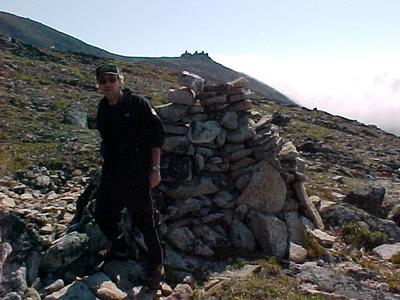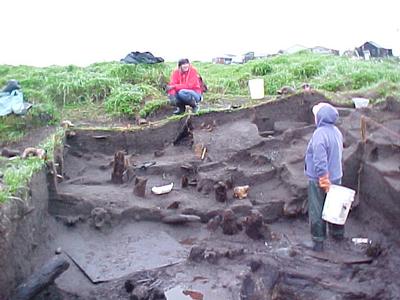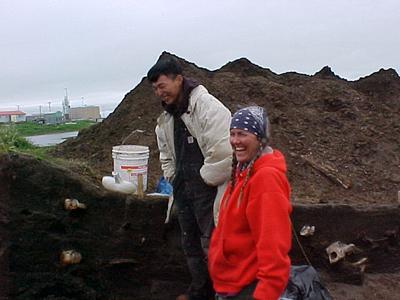22 July, 2001
Paglagivsigin - we welcome you Inupiaq
Today was our day of rest. I don't think so! John and I took a hike to the
top of the mountain overlooking Wales. At one point we could see the
clouds coming in below us. It was a breathtaking site. In the distance we
could see a series of three rock formations titled Ognaat (Women in
Inupiaq). They are nicknamed the Three Ladies or Three Sisters. At one
point there were five rock formations but two fell in an earthquake. The
story behind this is that supposedly there were sisters who were banished
from the village. When they left they were turned into stone. They sit
today on top of a mountain overlooking Wales.
As we hiked we came upon many Inuksuks (Inuksuits). These are rock
formations that serve in many ways. The ones we were following were
showing us the path to the top of the mountain. They sometimes show where
there is hunting, in memory of someone, or to simply just showing the
path. We also came upon a great deal of musk-ox fur as we climbed. It was
hard to imagine such a large animal walking down this path.
I have mentioned the many avenues in anthropology in previous days. I
would like to continue with Julie Hollowell-Zimmer. This is her fourth
trip with Dr. Harritt to Wales. She lives in Bloomington, Indiana. She
received her B.A. degree in psychology from Indiana University. She next
received her Masters in Education and proceeded to teach elementary school
for ten years. Once again she decided to go back to school and received
M.A. in Anthropology. Julie is currently working towards her Ph.D. in
cultural Anthropology. Her specialty is North American Native Peoples, and
the Social Context of Archaeology. She is writing her dissertation on:
Market in Archaeological Materials from Alaska's Bering Strait. This is
controversial because there are some archaeologists that believe
archaeological materials should not go on the market because it leads to
site destruction. People dig and desecrate sites for the sole purpose of
making money. These are social, ethical, and archaeological issues. She
became interested in this subject in Indiana. This happened, and many
Native Peoples felt this was desecrating a site. She has many concerns for
the Native peoples preserving their culture, artifacts being a major
aspect.
Her concerns in these issues are: There is an impact of archaeology on
Native Communities. There are ethical concerns of people making money on
their finds such as ivory for example. How can archaeology benefit local
communities? And what is the meaning of archaeology to local communities?
How do people relate to their culture? She seems to have a great
understanding and concern for people. Julie has stressed that one of the
reasons she likes to come to Wales is because of the philosophy,
everything belongs o the people of Wales. I have stated this in other
journal entries. All of these findings will come back to Wales. The people
can then decide what is to be done with all of the findings.
I would also like to thank her for all of her guidance in Wales. Julie has
taught me a great deal about the people, about archaeology, about
excavating, and of teaching!.

I am pictured here (the ancient artifact) next to an Inuksu which showed us the way to the top of this mountain. In the background are the Three sisters.

Julie (in red) is surveying the situation with Maria. We have to constantly study what and where we are with each level.

Julie and Wes share a laugh as we all look for a new level.
Contact the TEA in the field at
.
If you cannot connect through your browser, copy the
TEA's e-mail address in the "To:" line of
your favorite e-mail package.
|
